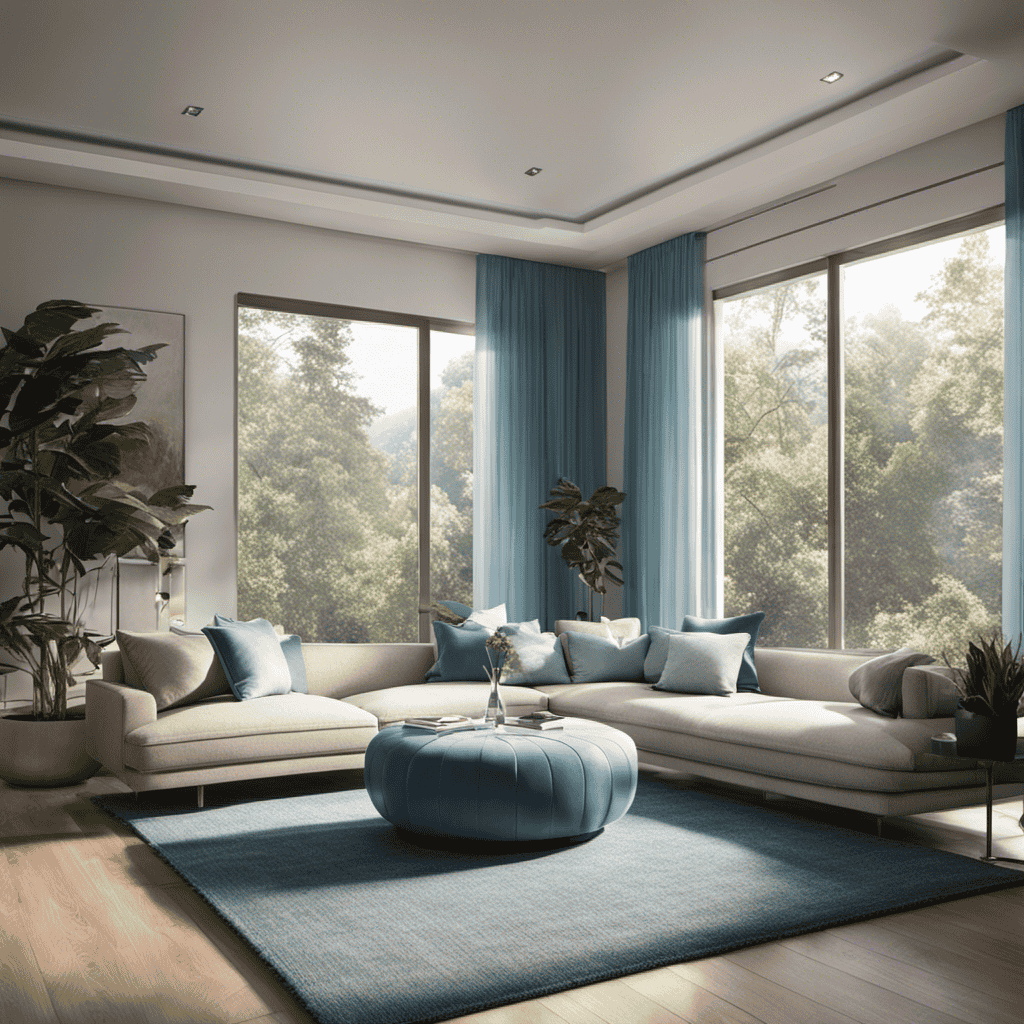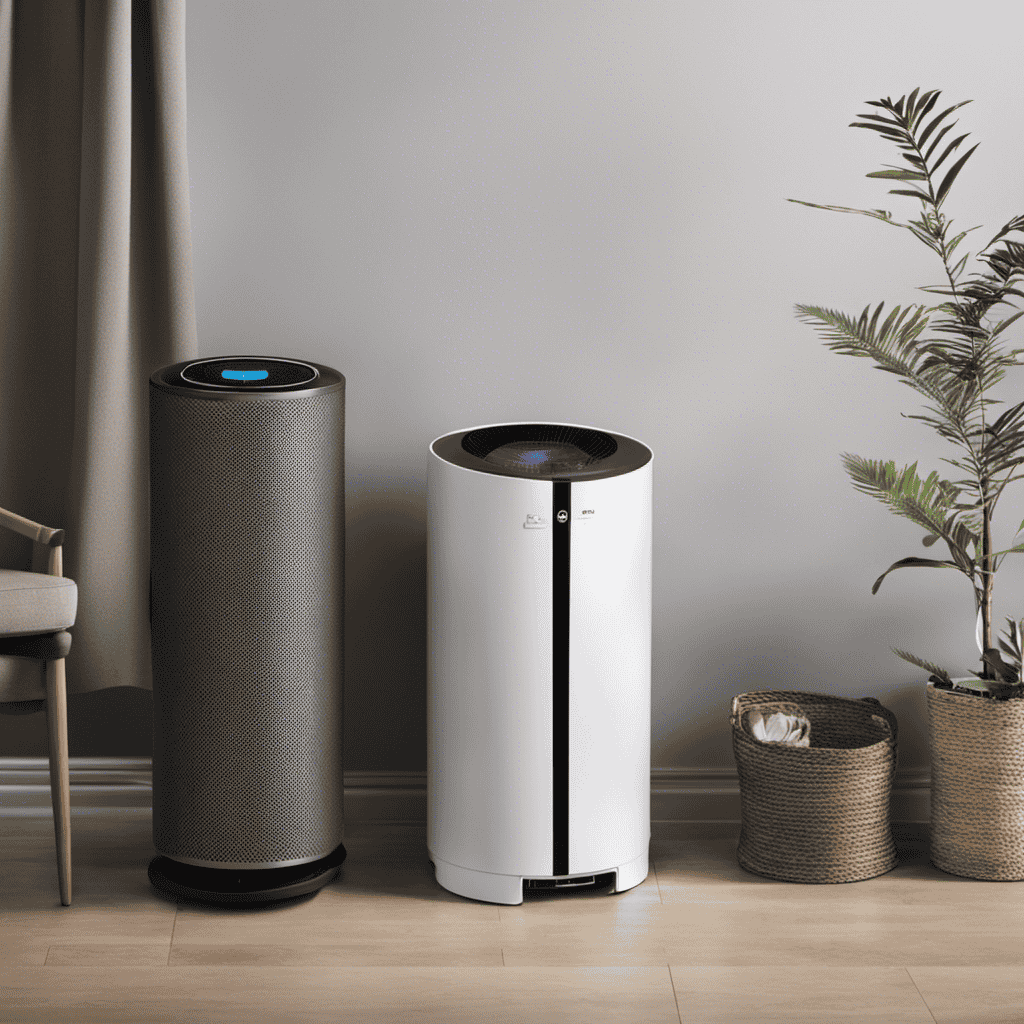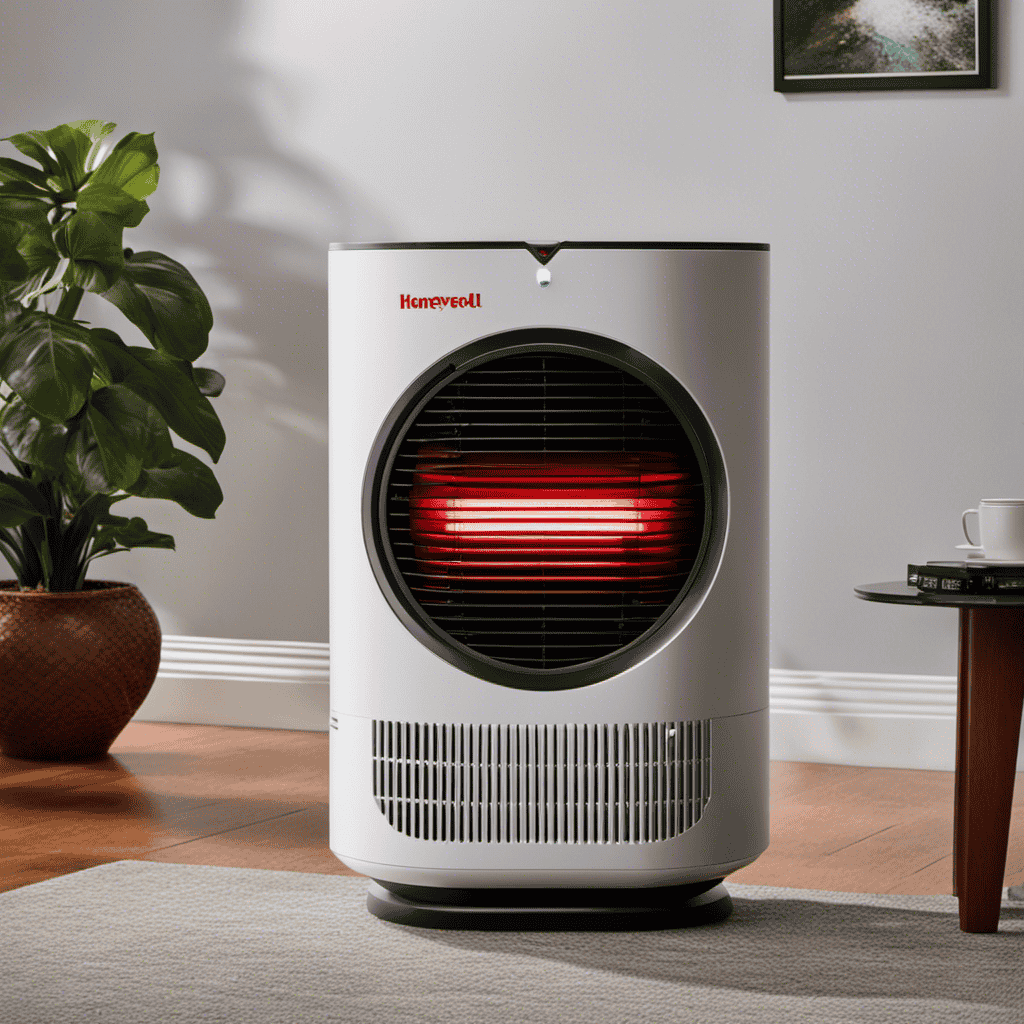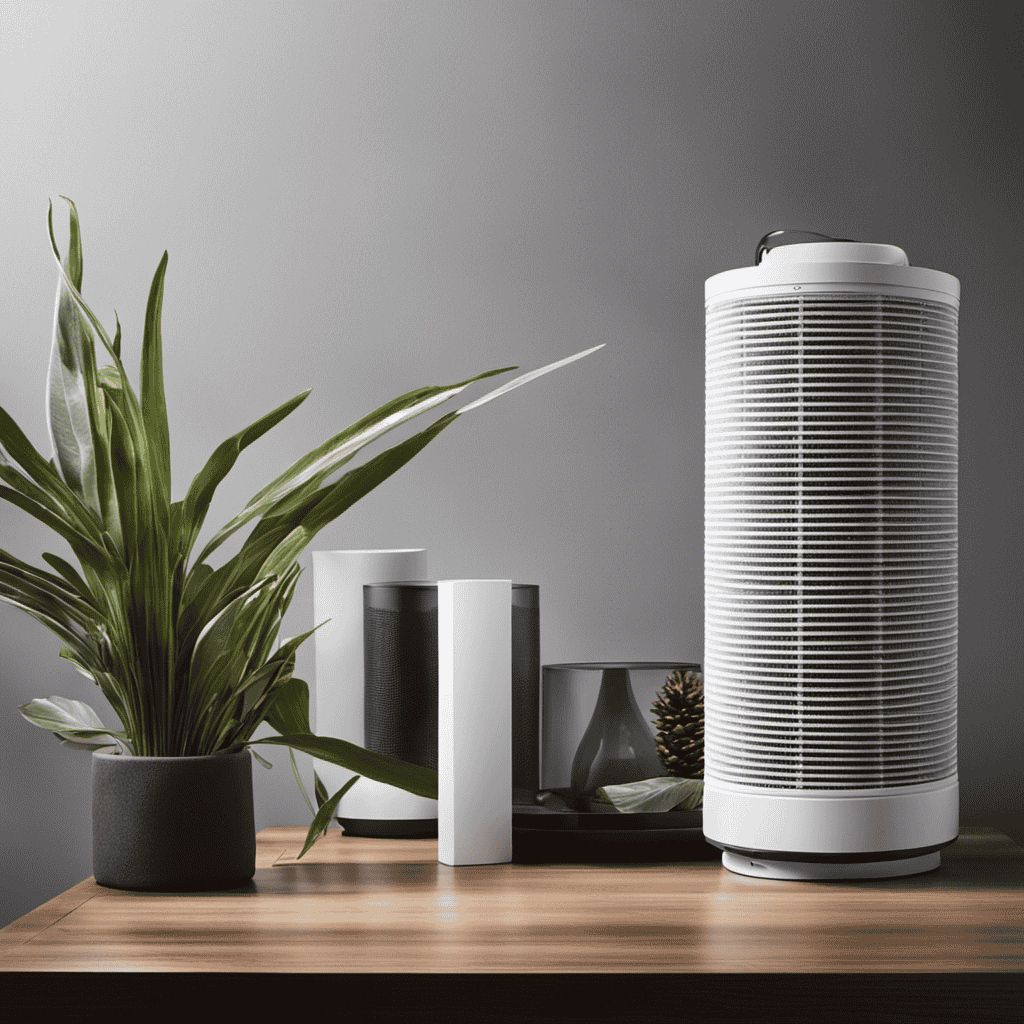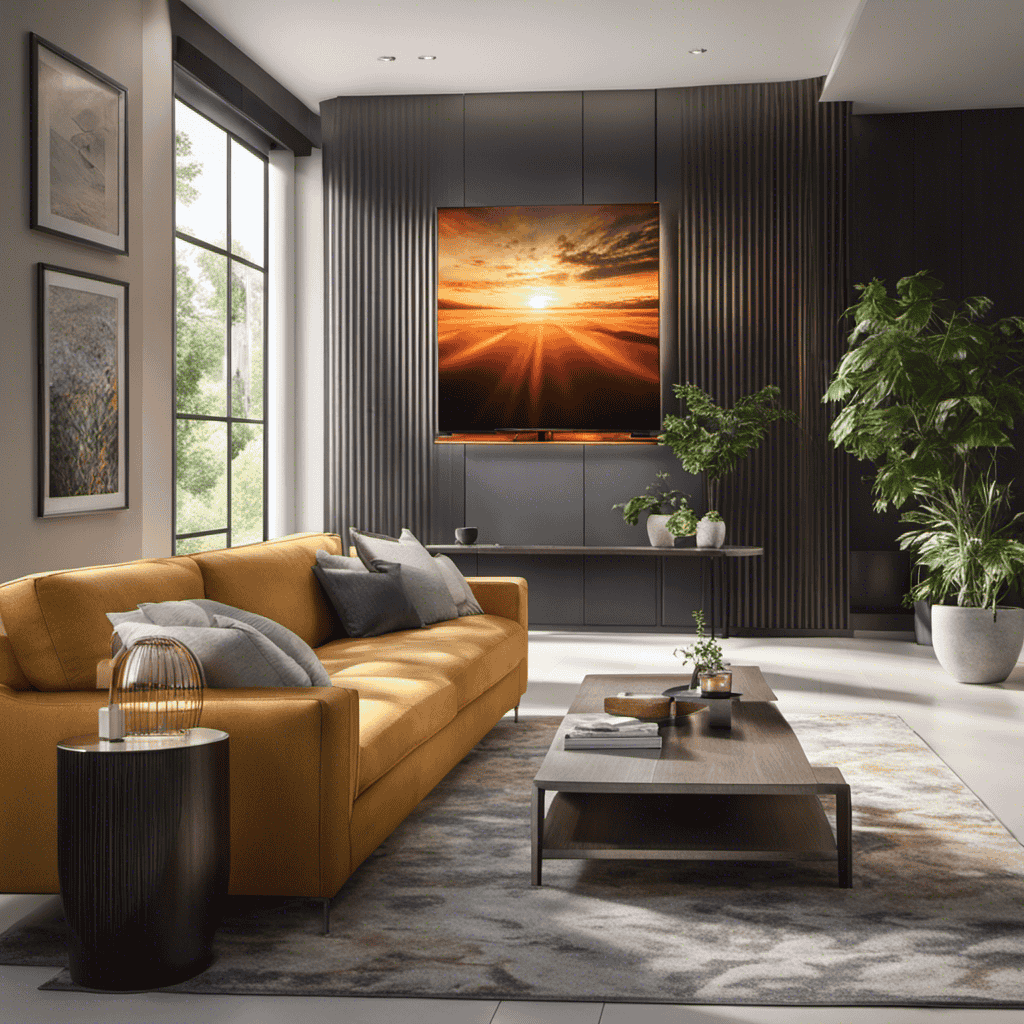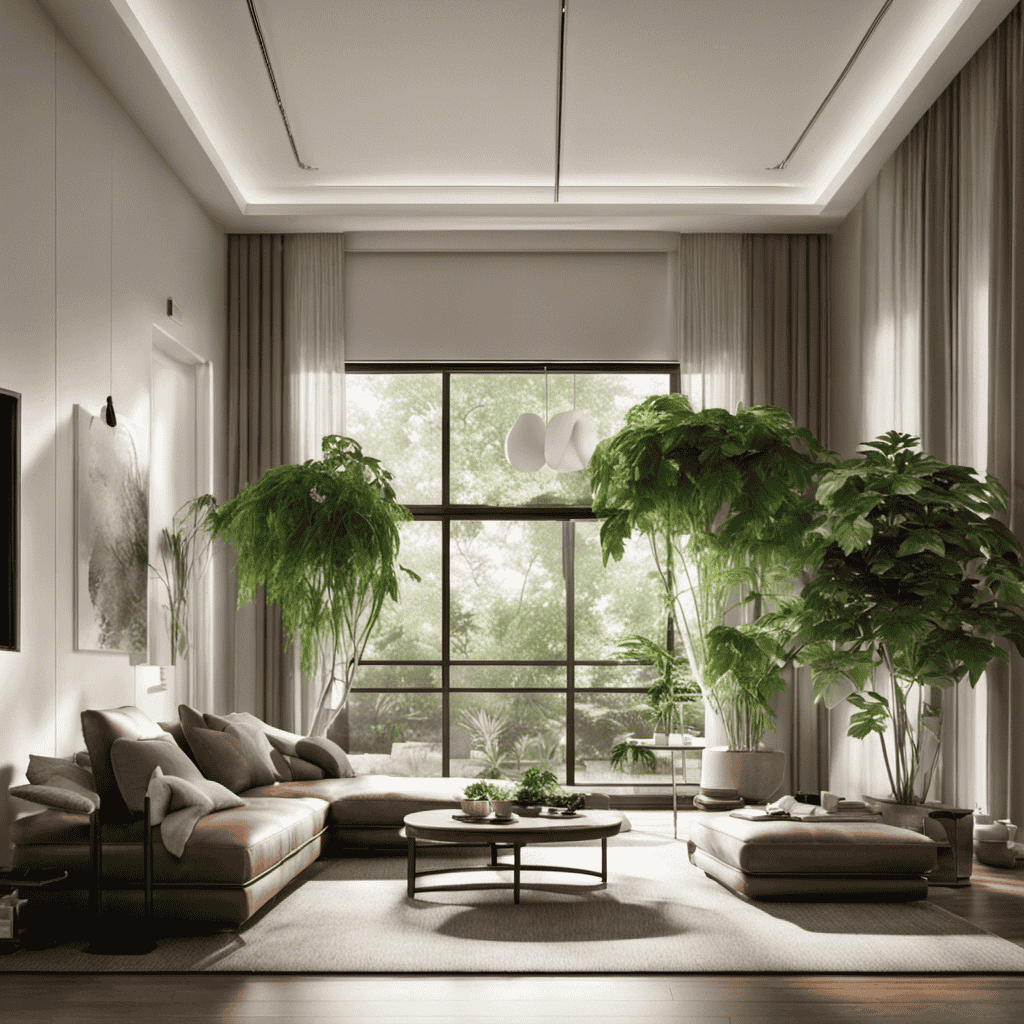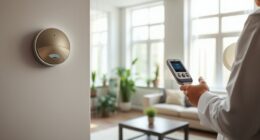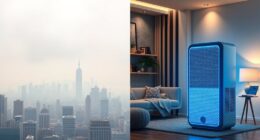I have news for you: the air in your home may not be as clean as you believe. But do not fret, there is a solution – an air purifier.
In this article, we’ll dive into the benefits of running an air purifier and give you the lowdown on how often to run it. We’ll also explore factors to consider, tips for choosing the right one, and how to optimize energy efficiency.
So get ready to breathe easy and keep your home clean and fresh.
Key Takeaways
- Regular maintenance is essential for optimal performance and longevity of the air purifier.
- Factors such as room size, air quality, and pollution levels should be considered when determining how often to run the air purifier.
- Filter replacement is necessary, and the lifespan of filters depends on factors such as filter quality and pollution levels.
- Monitoring and improving indoor air quality through various methods such as using monitoring devices, ventilating, and regular cleaning is crucial for a healthy living environment.
The Benefits of Running an Air Purifier
You’ll be amazed at the benefits of running an air purifier in your home.
Not only does it improve indoor air quality, but it also provides numerous health benefits.
Air purifiers work by removing pollutants and allergens from the air, such as dust, pet dander, pollen, and mold spores.
This can greatly reduce the risk of respiratory issues, allergies, and asthma attacks.
In addition, air purifiers help eliminate unpleasant odors, creating a fresh and clean environment.
Regular air purifier maintenance is important to ensure optimal performance.
This includes cleaning or replacing filters, regularly checking the unit for any issues, and keeping the surrounding area clean.
How Long Should You Run Your Air Purifier Each Day
When it comes to optimal daily air purifier usage, it is important to consider the benefits of extended operation.
Based on extensive research and data analysis, running your air purifier for longer durations can significantly improve indoor air quality by reducing the presence of airborne contaminants such as dust, pollen, and pet dander.
Extended operation also ensures continuous filtration, leading to a healthier and more comfortable living environment.
Optimal Daily Air Purifier Usage
To optimize daily air purifier usage, it’s important to consider factors such as room size and air quality.
One key aspect of maintaining an air purifier is regular maintenance. Cleaning or replacing the filters is essential to ensure optimal performance. A dirty filter can hinder the efficiency of the purifier and lead to poor air quality.
Additionally, it’s crucial to be mindful of the noise levels produced by the air purifier. Some models emit a significant amount of noise, which can be disruptive, especially during sleep or work hours. Look for air purifiers with low noise levels, typically measured in decibels (dB).
The ideal noise level is around 30 to 40 dB, ensuring a quiet and peaceful environment while the purifier effectively cleans the air.
Benefits of Extended Operation?
Extended operation of an air purifier can provide continuous filtration, improving indoor air quality throughout the day. By running your air purifier for longer periods of time, you can enjoy several benefits and long-term advantages. The table below outlines these benefits:
| Benefit | Description |
|---|---|
| Constant Filtration | Extended operation ensures that air is constantly filtered |
| Improved Allergen Removal | Continuous filtration helps remove allergens from the air |
| Reduced Indoor Air Pollution Levels | Extended operation helps maintain low pollution levels |
These benefits contribute to creating a healthier and more comfortable indoor environment. However, it is important to consider various factors when determining how often to run your air purifier. Understanding your specific needs, the size of your space, and the air quality in your area will help you make an informed decision. Transitioning into the next section, let’s explore these factors in more detail.
Factors to Consider When Determining How Often to Run Your Air Purifier
One important factor to consider when deciding how often to run your air purifier is the size of your living space. The larger the space, the more pollutants and allergens there are to filter out, so running the air purifier more frequently would be necessary.
However, there are other factors to consider as well:
-
Air quality: If you live in an area with high pollution levels or have pets or smokers in the house, running the air purifier more often would be beneficial for maintaining clean air.
-
Allergies: If you or your family members suffer from allergies, running the air purifier continuously or for longer periods can help reduce allergens in the air and provide relief.
-
Cost effectiveness: Running the air purifier constantly can increase electricity costs. It is important to find a balance between maintaining clean air and cost-effective usage. Setting a timer or using the air purifier on a schedule can help achieve this.
Understanding Air Quality Levels in Your Home
Understanding the air quality levels in your home can help you determine the effectiveness of your air purifier. It is important to be aware of the presence of air pollution indoors and its potential health effects. Indoor air pollution can come from various sources such as outdoor pollution, cooking activities, tobacco smoke, and household products. Monitoring the air quality in your home can provide valuable insights into the effectiveness of your air purifier in removing pollutants.
To better understand air quality levels, you can use a monitoring device that measures different pollutants such as particulate matter, volatile organic compounds (VOCs), carbon monoxide, and humidity levels. By regularly monitoring these levels, you can assess if your air purifier is effectively reducing the concentration of pollutants in your home.
The table below provides a visual representation of the different air quality levels and their corresponding health effects:
| Air Quality Level | Health Effects |
|---|---|
| Good | Minimal or no health risks |
| Moderate | Slight discomfort for sensitive individuals |
| Unhealthy | Health effects for sensitive groups |
| Hazardous | Serious health effects for everyone |
Understanding air pollution and its health effects is crucial for maintaining a healthy indoor environment. By monitoring air quality levels and using an effective air purifier, you can improve the air quality in your home and protect your health.
Tips for Choosing the Right Air Purifier for Your Space
When choosing an air purifier for your space, two key factors to consider are room size and filter replacement frequency.
Room size is important because it determines the efficiency and effectiveness of the air purifier in cleaning the air in your space. A larger room may require a more powerful air purifier to ensure that all the air is properly filtered.
Additionally, filter replacement frequency is a crucial consideration as it directly affects the long-term maintenance and cost of operating the air purifier. Understanding how often the filters need to be replaced will help you plan and budget accordingly.
Room Size Considerations
To determine how often you should run your air purifier, take into consideration the size of the room. Room size considerations play a crucial role in ensuring optimal air purification. Here are some key factors to keep in mind:
-
Square footage: Larger rooms require more air purifying power to effectively clean the air. Be sure to check the recommended room size for your specific air purifier model.
-
Air exchange rate: The number of times the air in a room is completely replaced per hour is an important factor. Consider the air exchange rate of your air purifier to determine how frequently it should run.
-
Pollution level: High pollution levels, such as in urban areas or during allergy seasons, might require running your air purifier more frequently.
Filter Replacement Frequency
Now that we have considered the importance of room size when running an air purifier, let’s shift our focus to the filter replacement frequency.
It is crucial to change the filters regularly to maintain optimal air quality. The lifespan of air purifier filters can vary depending on various factors, such as the quality of the filter itself and the level of pollution in your environment.
On average, HEPA filters last approximately 6 to 12 months, while activated carbon filters typically last for 3 to 6 months. However, it is important to note that these are just general guidelines, and it is essential to follow the manufacturer’s recommendations for your specific device.
To ensure the longevity of your filters, regular maintenance is key. This includes vacuuming or gently washing the filters, depending on the type, as well as keeping the surrounding area clean to minimize dust and debris accumulation.
The Importance of Regular Maintenance for Your Air Purifier
Make sure you don’t neglect the regular maintenance of your air purifier because it is essential for its effectiveness and longevity. Proper maintenance can prevent common air purifier problems and ensure that your unit continues to provide clean and healthy air.
Here are some air purifier maintenance tips to keep in mind:
-
Clean or replace the filters regularly to maintain optimal performance. Clogged filters can reduce airflow and decrease the purifier’s efficiency.
-
Check the fan and motor for any signs of dust or debris buildup. Clean the fan blades and motor housing to prevent overheating and motor failure.
-
Clean the exterior of the purifier regularly to remove dust and allergens that may accumulate on the surface.
By following these maintenance tips, you can maximize the lifespan of your air purifier and keep it functioning at its best.
Now, let’s explore how to monitor and improve indoor air quality.
How to Monitor and Improve Indoor Air Quality
Regularly checking and improving the quality of the air indoors is crucial for maintaining a healthy and comfortable living environment. One way to monitor indoor air quality is by using air quality monitoring devices. These devices can measure various pollutants such as particulate matter, volatile organic compounds (VOCs), and carbon dioxide levels. By monitoring these pollutants, we can take appropriate actions to improve the air quality.
In addition to using monitoring devices, there are also natural ways to improve indoor air quality. For example, keeping windows open for ventilation can help remove stagnant air and bring in fresh outdoor air. Houseplants can also play a role in improving air quality by absorbing harmful pollutants and releasing oxygen. Lastly, regular cleaning and dusting can help remove dust and allergens from surfaces, improving the overall air quality.
Below is a table that summarizes some common air pollutants and their potential health effects:
| Pollutant | Health Effects | Sources |
|---|---|---|
| Particulate Matter | Respiratory issues, heart disease | Combustion, dust, and pollen |
| VOCs | Eye, nose, and throat irritation | Cleaning products, paint |
| Carbon Dioxide | Drowsiness, poor concentration | Human respiration, combustion |
Signs That Your Air Purifier Needs to Be Replaced
If you notice a decrease in the effectiveness of your air purifier, it may be time to consider replacing it. Air purifiers are essential for maintaining clean and healthy indoor air quality, but over time, their performance can decline. Here are some signs that indicate your air purifier needs to be replaced:
-
Reduced airflow: If you notice a decrease in the airflow coming from your air purifier, it could be a sign that the filters are clogged and need replacement.
-
Unpleasant odors: If your air purifier is no longer effectively eliminating odors, it may be due to a worn-out filter that needs to be replaced.
-
Increased allergy symptoms: If you or your family members start experiencing more allergy symptoms, it could be a sign that the air purifier is no longer effectively removing allergens from the air.
To ensure the longevity and effectiveness of your air purifier, it’s crucial to follow these maintenance tips:
-
Regular filter replacement: Check the manufacturer’s recommendations for how often the filters should be replaced and make sure to follow it.
-
Cleaning the unit: Regularly clean the exterior and interior of the air purifier to prevent dust and debris buildup.
-
Proper placement: Ensure that your air purifier is placed in an optimal location to maximize its efficiency in cleaning the air.
The Role of Air Purifiers in Allergy Relief
Air purifiers can significantly alleviate allergy symptoms by effectively removing allergens from the air. These devices are designed to filter out common allergens such as pollen, pet dander, mold spores, and dust mites. By reducing the concentration of these irritants in the air, air purifiers can help improve respiratory health and provide relief for individuals suffering from allergies. In fact, studies have shown that using air purifiers can reduce symptoms such as sneezing, coughing, and itchy eyes.
To better understand the effectiveness of air purifiers in allergy relief, let’s take a look at the following table:
| Allergen | Air Purifier Efficiency |
|---|---|
| Pollen | 99% |
| Pet Dander | 98% |
| Mold Spores | 99.9% |
| Dust Mites | 99.5% |
As you can see, air purifiers have high efficiency rates in removing allergens from the air. This makes them an excellent choice for dust mite control, as dust mite allergens are a common trigger for allergies. By effectively capturing these allergens, air purifiers can help create a healthier indoor environment.
Now, let’s transition to the next section and explore how running an air purifier can help with asthma symptoms.
Can Running an Air Purifier Help With Asthma Symptoms
By using an air purifier, you can significantly reduce asthma symptoms and improve your respiratory health. Air purifiers work by filtering out airborne particles and allergens that can trigger asthma attacks. Here are three ways that running an air purifier can help with asthma symptoms:
-
Removes airborne allergens: Air purifiers effectively capture and remove common asthma triggers such as pollen, pet dander, dust mites, and mold spores from the air, reducing the risk of asthma attacks.
-
Improves indoor air quality: By continuously circulating and filtering the air, air purifiers can greatly improve the overall air quality in your home, reducing the presence of irritants and pollutants that can worsen asthma symptoms.
-
Reduces exposure to harmful chemicals: Some air purifiers are equipped with activated carbon filters that can absorb harmful chemicals and odors, creating a healthier environment for individuals with asthma.
Proper air purifier maintenance, such as regularly cleaning or replacing filters, is essential to ensure optimal performance and effectiveness in reducing asthma triggers.
Transitioning into the subsequent section about ‘air purifiers vs. other indoor air quality solutions,’ it is important to consider the benefits and limitations of air purifiers in comparison to alternative solutions.
Air Purifiers Vs. Other Indoor Air Quality Solutions
When comparing air purifiers to other indoor air quality solutions, you’ll find that different methods may be more effective depending on your specific needs and circumstances.
Air purifiers are designed to remove pollutants and allergens from the air, while humidifiers add moisture to dry indoor environments. Both devices have their benefits, but they serve different purposes.
Air purifiers are particularly effective in removing airborne particles such as dust, pollen, and pet dander, which can trigger allergies and respiratory issues. On the other hand, humidifiers are ideal for adding moisture to the air, which can alleviate dry skin, irritated eyes, and respiratory discomfort.
Ventilation systems, on the other hand, are designed to improve air circulation and exchange within a building. These systems remove stale air and bring in fresh outdoor air, reducing the concentration of indoor pollutants.
While air purifiers and humidifiers can improve indoor air quality on their own, ventilation systems provide a more comprehensive solution by addressing the source of pollutants and ensuring a continuous supply of clean air.
Ultimately, the choice between air purifiers, humidifiers, or ventilation systems depends on your specific needs and the air quality concerns you want to address.
How to Optimize Energy Efficiency While Running Your Air Purifier
To optimize energy efficiency while using your air purifier, you can adjust the settings to run on a lower fan speed during periods when you are not at home or when the air quality is already good. This simple technique can help you save energy and reduce your electricity bills.
Here are some additional optimal energy saving techniques for cost-effective air purification:
-
Use a timer: Set your air purifier to run for specific periods of time, such as when you are sleeping or during peak pollution hours.
-
Clean or replace filters regularly: Clogged filters can reduce the airflow and make your air purifier work harder, consuming more energy. By keeping the filters clean, you can maintain optimal performance and energy efficiency.
-
Place the air purifier strategically: Position the air purifier in a central location where it can effectively circulate and clean the air in the room, reducing the need for higher fan speeds.
The Impact of Seasonal Changes on Air Purifier Usage
As the seasons change, so does the quality of the air we breathe. During the winter months, indoor air quality can be negatively affected by factors such as increased use of heating systems and reduced ventilation. This can lead to higher levels of pollutants and allergens in the air, making it essential to use an air purifier to maintain a healthy indoor environment.
During allergy season, the effectiveness of air purifiers becomes crucial in reducing the presence of airborne allergens such as pollen, dust mites, and pet dander. By capturing and filtering these allergens, air purifiers can alleviate symptoms and provide much-needed relief.
Additionally, in the summer months, air purifiers can help control humidity levels by removing excess moisture from the air. This not only improves comfort but also helps prevent the growth of mold and mildew, which can have adverse effects on both air quality and overall health.
Winter Air Quality
During the winter months, it’s important to regularly run your air purifier to maintain optimal air quality in your home. Winter air pollution can significantly impact indoor air quality, trapping pollutants like fine particles, carbon monoxide, and volatile organic compounds (VOCs) indoors.
Here are three reasons why consistent use of your air purifier is crucial during this time:
-
Reduction of fine particles: Air purifiers with HEPA filters can effectively remove particles as small as 0.3 microns, including dust, pollen, and pet dander. This improves indoor air quality and helps keep your home clean.
-
Elimination of carbon monoxide: Carbon monoxide can seep into your home during winter, not just from cars and furnaces. Air purifiers equipped with activated carbon filters can help eliminate this dangerous gas, ensuring the safety of your family.
-
Removal of volatile organic compounds (VOCs): Household products like cleaning supplies, paint, and furniture release VOCs that can diminish indoor air quality. Air purifiers with activated carbon filters can effectively capture and eliminate these harmful compounds, creating a healthier environment.
Regular use of your air purifier during winter is essential to ensure that your home’s air remains clean and healthy. So, make sure to keep it running consistently to combat winter air pollution and maintain optimal indoor air quality.
Allergy Season Effectiveness
Make sure you’re using your air purifier consistently during allergy season to effectively improve indoor air quality and reduce allergens in your home. Allergy season, especially during the peak pollen season, can be particularly challenging for individuals with allergies or respiratory issues. An air purifier can be a valuable tool in reducing indoor allergens and providing relief. To understand the effectiveness of using an air purifier during pollen season, let’s take a look at the following data-driven table:
| Effectiveness of Air Purifier during Pollen Season |
|---|
| Reduces pollen particles in the air |
| Filters out mold spores and dust mites |
| Improves air quality and reduces allergy symptoms |
| Removes pet dander and other common allergens |
| Provides relief for individuals with respiratory issues |
Summer Humidity Control
Controlling humidity in the summer is essential for creating a comfortable indoor environment. High humidity levels can lead to a range of problems, including mold growth, musty odors, and increased discomfort. To effectively control humidity, there are several methods you can use:
- Use a dehumidifier: Dehumidifiers are effective at reducing excess moisture in the air, helping to maintain a comfortable humidity level.
- Ventilate properly: Ensure that your home is adequately ventilated, allowing fresh air to circulate and prevent moisture buildup.
- Monitor humidity levels: Use a hygrometer to regularly measure the humidity in your home and adjust accordingly.
Using dehumidifiers offers several benefits:
- Prevents mold and mildew growth: By reducing excess moisture in the air, dehumidifiers help prevent the growth of mold and mildew, which can cause health issues.
- Improves indoor air quality: Dehumidifiers can help remove allergens and pollutants from the air, improving the overall air quality in your home.
- Increases comfort: By maintaining a comfortable humidity level, dehumidifiers can help you feel more comfortable and reduce the need for excessive air conditioning.
By implementing these humidity control methods and using dehumidifiers, you can create a pleasant and healthy indoor environment during the summer.
In the subsequent section, we will explore how air purifiers can help keep your home clean, specifically in relation to pet dander.
Air Purifiers and Pet Dander: How to Keep Your Home Clean
If you have pets, it’s important to know how often to run your air purifier to keep your home free from pet dander. Pet dander is a common allergen that can cause discomfort and health issues for individuals with pet allergies. By using an air purifier, you can reduce the amount of pet dander in your home and create a healthier environment. The frequency of running your air purifier depends on various factors such as the size of your home, the number of pets, and the severity of pet allergies. Refer to the table below for general guidelines on how often to run your air purifier based on these factors:
| Home Size | Number of Pets | Severity of Pet Allergies | Frequency of Running Air Purifier |
|---|---|---|---|
| Small | 1 | Mild | 4-6 hours per day |
| Medium | 2 | Moderate | 6-8 hours per day |
| Large | 3+ | Severe | 8-10 hours per day |
Setting a Schedule: Creating a Routine for Running Your Air Purifier
When it comes to optimal purifier usage, consistency and effectiveness are key factors to consider. To achieve the best results, it’s important to run the air purifier consistently, following a set schedule.
Optimal Purifier Usage
To get the most out of your air purifier, it’s important to know how often to run it. Proper air purifier maintenance and setting the recommended air purifier settings can greatly improve the air quality in your home. Here are some guidelines to help you optimize your purifier usage:
-
Consider the size of your space: The frequency of running your air purifier depends on the square footage of the area you want to purify. Smaller rooms may require less runtime compared to larger spaces.
-
Assess the air quality: If you live in an area with high pollution levels or have respiratory issues, running your air purifier continuously is recommended. For moderate air quality, running it for a few hours each day should suffice.
-
Follow manufacturer’s instructions: Each air purifier model may have specific recommendations for optimal usage. Refer to the user manual for guidance on the ideal runtime and settings.
Consistency and Effectiveness
Maintaining a consistent schedule for my air purifier ensures its effectiveness in improving indoor air quality.
To measure its effectiveness, I rely on the Clean Air Delivery Rate (CADR), which quantifies the volume of clean air produced by the purifier. CADR ratings for different pollutants, such as dust, pollen, and smoke, help me choose the most suitable air purifier for my needs.
Running the purifier continuously or for extended periods may seem tempting, but it’s important to consider the impact on my electricity bill.
Frequently Asked Questions
Are There Any Health Risks Associated With Running an Air Purifier Too Often?
Running an air purifier too often may not have any health risks. However, it is important to consider the long-term effects. Regular use can provide health benefits by reducing indoor air pollutants.
Can Running an Air Purifier Improve the Quality of Sleep?
Running my air purifier regularly improved my sleep quality. It eliminated allergens and pollutants, creating a cleaner and healthier environment. I noticed a significant decrease in my insomnia symptoms and woke up feeling more refreshed.
Are There Any Specific Filters or Features to Look for When Choosing an Air Purifier for a Larger Space?
When choosing an air purifier for a larger space, it’s important to consider specific filters and features. Look for HEPA filters for effective purification and energy efficiency to ensure optimal air purifier maintenance.
How Do Air Purifiers Affect Humidity Levels in the Home?
Air purifiers can help maintain optimal humidity levels in the home by reducing excess moisture or dryness. They can also effectively remove pet dander and allergens from the air, improving indoor air quality.
Can Air Purifiers Remove Cooking Odors or Other Strong Odors From the Air?
Air purifiers can effectively remove cooking odors and other strong odors from the air. They work by filtering out particles and pollutants, including pet dander and cigarette smoke, improving the overall air quality in your home.
How Does Cleaning My Air Purifier Affect its Running Frequency?
Regularly cleaning your air purifier can have a significant impact on its running frequency. When you clean air purifier regularly, it can work more efficiently, resulting in a decrease in its running frequency. This not only helps to prolong the life of the purifier but also ensures cleaner air in your home.
Conclusion
In conclusion, running an air purifier is like having a loyal guardian that tirelessly cleans the air in your home. By understanding factors such as air quality levels and seasonal changes, you can determine how often to run it.
Choosing the right air purifier and optimizing energy efficiency are crucial for maintaining a healthy environment. Don’t forget about those pesky pet dander particles!
With a well-defined schedule, your air purifier will keep your home fresh and clean, ensuring a breath of fresh air for you and your loved ones.
